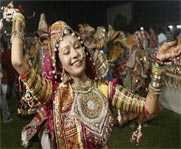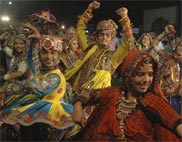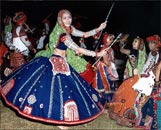GARBA
Origin
Garba is the popular dance from Gujarat and is being performed not only all over India but all over the world by the Gujaratis. Garba is an Indian form which has originated in the Gujarat region. It is more similar to the classical Indian dances such as Bharatanatyam and Odissi. The name garba comes from the Sanskrit term Garba which means "belly" and Deep which means "a small earthen lamp" while many traditional sheaves are performed around a central lighted lamp.Garbha is a circular form of dance performed by ladies on the Navaratri days which are auspicious days of Goddess Durga in the Winter Months, during Sharad Purnima, Vasant Panchami, Holi and other festive occasions.
The performances of the dance are arranged by different clubs and cultural committees. During the 'Garba night', the participants gather at an open space, a club or at street corners. They stand in a circle, around an idol or photograph of the goddess that is kept in the center. The dance in mood begins with beats in slow tempo. As the dance proceeds, the energy level of the participants increases due to the fast beat and tempo of the music. The music is synchronized by a drummer who stands in the center of the dancers.
 Navratri Garba is the most colorful form of dance in India. The performers of Garba dance are both men and women, who would clad themselves in colorful and magnetically attractive traditional attire. The most chosen attire for the dance is sari for women worn in the typical Gujarati style. In Saurashtra region, the performers of Garba Dance would wear magnificently embroidered petticoats, Ghaghara with a backless choli kapdu, which would be accessorized with a head cover odhani. The dancers decorate themselves with lots of silver jewelry on their head. Their male counterpart would wear kediyum shirt and vajani trouser, with a rumal which is a printed headpiece. In traditional Garba dance the musical instrument usually used are Drum, harmonium and naal.
Navratri Garba is the most colorful form of dance in India. The performers of Garba dance are both men and women, who would clad themselves in colorful and magnetically attractive traditional attire. The most chosen attire for the dance is sari for women worn in the typical Gujarati style. In Saurashtra region, the performers of Garba Dance would wear magnificently embroidered petticoats, Ghaghara with a backless choli kapdu, which would be accessorized with a head cover odhani. The dancers decorate themselves with lots of silver jewelry on their head. Their male counterpart would wear kediyum shirt and vajani trouser, with a rumal which is a printed headpiece. In traditional Garba dance the musical instrument usually used are Drum, harmonium and naal. In the very earlier primitive form of Garba dance, the women used to place the pot 'Garba', with lamp on their head and move in a circular motion along the circle. The women sing and clap their hands simultaneously and synchronize their circular steps, very gracefully. The dance is accompanied by folk instruments and the pot is filled with a betel nut and a silver coin. On top of the pot coconut is placed, giving it the appearance of a holy 'Kumbh'. In the interiors of Gujarat, there exists a tradition, according to which, women place the perforated earthen pot (with the lamp inside it) at the center on a stool and dance around it, by clapping their hands and singing songs in the praise of Goddess Jagdamba.
Steps involved in the dance
 The dance involves circular and spiral figure which is spiritual. Traditionally the dance is held during the festival of nine days of Navaratri . A lamp (the Garba Deep), or an image of the goddess Amba is placed in the middle of concentric rings as an object of veneration. People dance around the center, leaning to one side every step, their arms gesturing radicals, each movement ending in applause.
The dance involves circular and spiral figure which is spiritual. Traditionally the dance is held during the festival of nine days of Navaratri . A lamp (the Garba Deep), or an image of the goddess Amba is placed in the middle of concentric rings as an object of veneration. People dance around the center, leaning to one side every step, their arms gesturing radicals, each movement ending in applause.
The dance form of Garba has more fluid movements with hands clapping in unison, bodies gracefully bending sideways while every step and arms coming together in beautiful sweeping gestures in different directions. Where almost always all the movement ends in a clap. Garba is dance performed differently in different regions of Gujarat and different communities have evolved their own style and steps.
Garba Dance basic dance steps involves singing and clapping rhythmically while going round the goddess Durga. Garba is the leading dance of women in Gujarat and is performed throughout the nine nights of Navaratri.
 The actual performance usually begins at night after the women finish their house hold work. All the women gather at street corners and the folks come out into the open with perforated earthen pots holding lighted lambs poised on the head and sing, clap.Garba songs are generally in the praise of Mother Goddess Amba.
The actual performance usually begins at night after the women finish their house hold work. All the women gather at street corners and the folks come out into the open with perforated earthen pots holding lighted lambs poised on the head and sing, clap.Garba songs are generally in the praise of Mother Goddess Amba.The rhythm is always kept by a Dholi or drummer who sit in the centre. The costumes and the instruments used are very much traditional which mostly consist of a short coat called Kedia with tight sleeves with embroidered borders and shoulders, tight trousers like the Churidars and colourfully embroidered caps or coloured turbans and a coloured waist band.
Today the Garba dance is divided into two types- modern and traditional dances. Different types of Raas Garba are Dandia Raas, Taliclap Raas, Khanjari musical instrument raas, Manjira musical instrument raas, diva clay lamp raas, Tippni special stick raas, Talwar raas, beda raas, thaliplate raas,etc.
Learning the Garba
-
Panghat Peforming Arts
E-502 Shriji Enclave, Opp Sajan Appartment, Anandnagar Char Rasta, Satellite, Ahmedabad – 380015
Ph: +(91)-(79)-26920188
Email: [email protected]
-
Arya Dance Academy
Phone: Toll Free 866-279-2468 or 973-402-4655
Fax: 973-402-2281
Registering for Dance Class [email protected]
Performances for Shows/Events [email protected]
-
Kala Rydham Nruthya Academy
8, Srujan Flat, Nr. C.N. Vidhyalay, Ambawadi, Ahmedabad. 380006
Ph: +91-99092671788
Email : [email protected]


